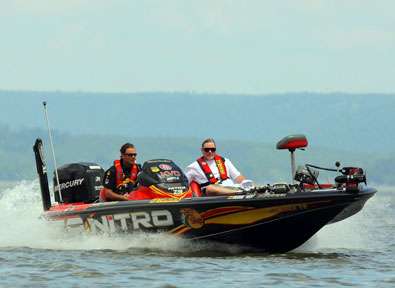
You might not think finesse fishing belongs in a power fishing angler's repertoire, but it does play a role in mine.
Sure, I prefer fishing faster moving lures on heavier line. However, I've discovered many finesse baits are great lures to work through an area where I've just caught bass on other lures.
I will catch the most aggressive fish with a fast horizontal presentation, but there may be 30 other fish down there that prefer more of a deliberate, vertical presentation.
Also, if environmental conditions change, the bass that were aggressive in an area may become reluctant to chase a lure and prefer one that falls seductively in front of them.
However, my style of finesse fishing is different than most. A slow, methodical approach works, but it doesn't fit my style or demeanor. It's difficult for me to go down a bank dragging a finesse bait all the way back to the boat. I only have one gear — fast — so I have to apply all techniques into what works best for me.
I blend my power tactics with all aspects of finesse fishing. That includes shaky head worms, drop shot rigs, tubes and lightweight jigs.
Regardless of what bait or technique I use, I want to be as efficient as possible, especially in a tournament situation. I want to catch as many as I can quickly.
I play the percentages; I make precise casts to spots where I believe the bass should be, work the lure a short time, then get it back in for another cast.
The key to making this work with finesse lures is to narrow the pattern to specific key areas. I want to know I'll get 80 percent of my bites on a certain type of structure and on the first couple of casts. Once I figure that out, I will pull up and fish the "meat" of a spot quickly and move to the next one.
I'll cast a shaky head worm, for example, shake it a few times and quickly make another cast.
I apply the same principle when fishing the Great Lakes with tube jigs. Tube bites tend to occur on the initial fall, so I'll cast with a heavy tube head that falls fast. I'll shake it, snap it 3 or 4 times then reel it in and do it over again.
It also works when the fish are on corner dock posts. I'll fish each corner post quickly and move to the next dock. Most guys will take the time to fish the entire dock with hopes of catching other fish.
Not me.
I fish similarly with the drop shot rig, one of my favorite finesse techniques for covering deep and shallow flats when I'm uncertain where the bass are holding. Also, if the fish are roaming, a drop shot attracts bites when other lures aren't working.
By using a little heavier sinker, I can cast farther, get it to the bottom quickly, work it a few times, and make more casts while most anglers are fishing only one.
The heavier sinker keeps the line tight and puts a ton of action in the lure while I shake it. If I don't get a bite, I wind in and hit another spot.
Increasing the weight on finesse rigs goes against traditional thinking. I realize lighter sinkers give the lure a more natural reaction. However, when the fish are in neutral or negative moods, a faster fall can trigger strikes better than a slow fall.
But then, I'm an extremist. I always start with 3/8- or even 1/2-ounce weights and work my way down until I find the right combination, knowing that the lighter sinker may be best. But if they'll hit the heavier weight just as well — or perhaps better — I can fish faster and more efficiently.
Same goes for a tube jug. It's not uncommon for me to throw a tube with a 1/2- or even a 3/4-ounce head. It sinks like a bowling ball, but still produces an erratic fall. I'll hit the bottom, snap it three or four times, reel in and do it again. You can cover a ton of water like that.
And what about tackle? I want to use the heaviest gear I can use effectively.
I can overcome a lot of things by using a longer rod with slightly heavier fluorocarbon line because fluorocarbon is far less visible. People think you get more bites with 6-pound line, and you might. But when throwing around docks and cover, you're going to land more quality fish with 10-pound line. It's about being efficient.
You can throw a 3/4-ounce jig head on 10-pound line and the difference between 6 and 10 doesn't change the fall much. But when you make a long cast with it, the lack of stretch in 10-pound fluorocarbon versus 8-pound monofilament line gives you a better hook set and allows you to land more fish.
Besides, when you using a heavy weight, the fish don't notice the line because it's falling fast. It doesn't change the action of the bait, either, but it does trigger more reactionary strikes.
If fishing finesse lures in the traditional sense works for you, that's great. But if you want to increase your efficiency and cover more water, power finesse fishing is a good option.




